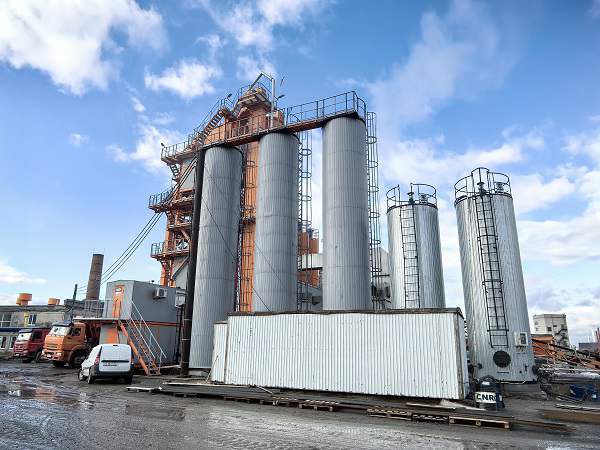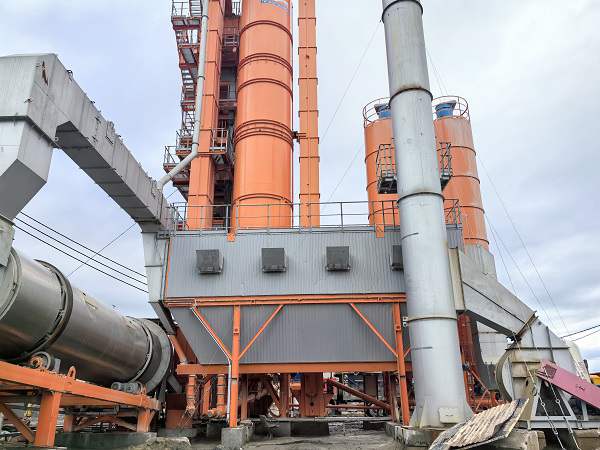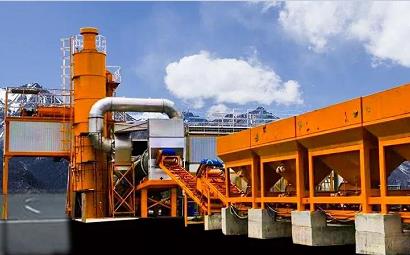Analysis of common faults in asphalt mixing plants
In asphalt pavement construction, asphalt concrete mixing plants are key equipment to ensure construction quality and improve efficiency. In the construction of domestic high-grade highway pavements, almost all imported asphalt mixing plants are used. The general specifications are more than 160 hours. The equipment investment is large and is a very critical part of the pavement construction technology.
The efficiency of the asphalt mixing plant and the quality of the concrete produced are related to whether the asphalt concrete mixing plant fails and the type and probability of failure. Combining many years of experience in asphalt concrete production and electric flat truck construction, the causes of failures in asphalt concrete mixing plants are analyzed to provide some experience in promoting the development of asphalt concrete and ensuring the construction quality of high-grade asphalt pavement.
1. Unstable output and low equipment production efficiency
In construction production, this kind of phenomenon is often encountered. The equipment production capacity is seriously insufficient, and the actual production capacity is far lower than the equipment specification capacity, resulting in equipment waste and low efficiency. The main reasons for this type of failure include the following aspects:
(1) Improper asphalt concrete mix ratio. Asphalt concrete mix ratio target mix ratio and production mix ratio. The target mix ratio controls the cold material transportation ratio of sand and gravel materials, and the production mix ratio is the mixing ratio of various types of sand and stone materials in the finished asphalt concrete materials specified in the design. The production mix ratio is determined by the laboratory, which directly determines the off-site grading standard of the finished asphalt concrete. The target mix ratio is set to further ensure the production mix ratio, and can be appropriately adjusted according to the actual situation during production. When the target mix ratio or the production mix ratio is not appropriate, the stones stored in each measurement of the asphalt plant will be disproportionate, with some overflowing and some other materials, unable to be weighed in time, and the mixing cylinder will be idling, resulting in reduced output.
(2) The gradation of sand and stone is unqualified.
Each specification of sand and stone has a gradation range. If the feed control is not strict and the gradation seriously exceeds the range, a large amount of "waste" will be produced, and the metering bin cannot measure in time. Not only does it result in low output, but it also wastes a lot of raw materials.
(3) The water content of sand and stone is too high.
The production capacity of the drying drum of the asphalt mixing station matches the equipment model accordingly. When the water content in the sand and stone is too high, the drying capacity decreases, and the amount of sand and stone supplied to the metering bin to reach the set temperature per unit time is small. This reduces production.
(4) The fuel combustion value is low. There are certain requirements for the combustion oil used in asphalt plants. Generally, diesel, heavy diesel or heavy oil is burned. During construction, in order to be cheap, mixed oil is sometimes burned. This kind of oil has low combustion value and low heat, which seriously affects the heating capacity of the drying barrel. .
(5) Equipment operating parameters are improperly set.
Mainly reflected in the improper setting of dry mixing and wet mixing time and improper adjustment of bucket door opening and closing time. Under normal circumstances, each mixing production cycle is 45 seconds, which just reaches the rated production capacity of the equipment. Taking the 2000 type equipment as an example, the stirring cycle is 45s, the hourly output Q = 2×3600/ 45= 160t/h, the stirring cycle time is 50s, the hourly output Q = 2×3600/ 50= 144t/h (Note: The rated capacity of the 2000 type mixing equipment is 160t/h). This requires that the mixing cycle time be shortened as much as possible while ensuring quality.
2. The discharging temperature of asphalt concrete is unstable
During the production process of asphalt concrete, there are strict requirements for temperature. If the temperature is too high, the asphalt will be easily "burned", commonly known as "paste", which has no use value and must be thrown away; if the temperature is too low, the asphalt will adhere unevenly to the sand and gravel, commonly known as "white material". The loss of "paste" and "white material" is staggering, and the cost per ton of material is generally around 250 yuan. If an asphalt concrete production site discards more waste on site, it reflects the lower its management and operation level. There are two reasons for this kind of failure:
(1) The asphalt heating temperature control is inaccurate. If the temperature is too high, "paste" will be produced; if the temperature is too low, "white material" will be produced.
(2) The heating temperature control of sand and gravel materials is inaccurate. Improper adjustment of the burner flame size, failure of the emergency damper, changes in moisture content in the sand and gravel, lack of material in the cold material bin, etc., can easily cause waste. This requires careful observation, frequent measurement, and a high sense of quality responsibility during the production process.


3. The oil-stone ratio is unstable
The whetstone ratio refers to the ratio of the quality of asphalt to the quality of fillers such as sand in asphalt concrete. It is an important indicator for controlling the quality of asphalt concrete. If the oil-stone ratio is too large, "oil cake" will appear on the road surface after paving and rolling. If the oil-stone ratio is too small, the concrete material will diverge and the concrete will not be formed after rolling. These are all serious quality accidents. The main reasons are:
(1) The soil and dust content in sand and stones seriously exceeds the standard. Although the dust has been removed, the mud content in the filler is too large, and most of the asphalt is combined with the filler, commonly known as "oil absorption". There is less asphalt adhering to the surface of the gravel, making it difficult to form by rolling.
(2) Measuring system failure. The main reason is that the zero point of the measurement system of the asphalt weighing scale and the mineral powder weighing scale drifts, causing measurement errors. Especially for asphalt measuring scales, an error of 1kg will seriously affect the oil-stone ratio. In production, the measurement system must be calibrated frequently. In actual production, due to the large amount of impurities contained in the mineral powder, the door of the mineral powder measurement bin is often not closed tightly, resulting in leakage, which seriously affects the quality of asphalt concrete.
4. The dust is large and pollutes the construction environment.
During construction, some mixing plants are filled with dust, seriously polluting the environment and affecting the health of workers. The main reasons are:
(1) The amount of mud and dust in sand and stone materials is too large and seriously exceeds the standard.
(2) Secondary dust removal system failure. Asphalt mixing plants currently generally use dry secondary bag dust collectors, which are made of special materials with small pores, good air permeability, and high temperature resistance. They are expensive, but have good effects and can meet environmental protection requirements. The main cause of pollution is that the pulse air pressure of the bag is too low, or some units do not replace it in time after damage in order to save money. The bag is damaged or blocked, the fuel combustion is incomplete, and impurities are adsorbed on the surface of the bag, causing blockage and causing the dryer to become cold. Dust is flying at the entrance of the material; the bag is damaged or not installed, and the smoke appears as "yellow smoke", but is actually dust.
5. Maintenance of asphalt concrete mixing plant
The asphalt mixing plant at the construction site is a piece of equipment that is prone to failure. Strengthening the maintenance of this equipment plays an important role in ensuring safe construction at the construction site, improving equipment integrity, reducing equipment failures, and ensuring concrete quality.
Normally, the maintenance of the mixing plant is divided into maintenance of the tank, maintenance and adjustment of the winch system, adjustment and maintenance of the stroke limiter, maintenance of the wire rope and pulleys, maintenance of the lifting hopper, and maintenance of the track and track brackets. wait. The tank is the working device of the asphalt mixing plant and is subject to serious wear and tear. In general, the liner, blade, mixing arm and material door seal must be adjusted and replaced frequently depending on the wear and tear. After each mixing of concrete, the tank must be flushed in time, and the remaining concrete in the tank and the concrete adhering to the material door must be thoroughly flushed to prevent the concrete in the tank from solidifying. The flexibility of opening and closing the material door should be checked frequently to prevent the material door from getting stuck. The thick oil pump is operated twice per shift to supply oil to the shaft end of the tank to lubricate the bearings and discharge sand, water, etc. When maintaining the tank, be sure to disconnect the power supply and have someone take care of it to avoid accidents. Make sure there are no foreign objects in the tank before starting the machine each time, and it is strictly prohibited to start the host with load.
Maintenance and adjustment of winch motor: The braking system of the winch system of the aspahlt mixing station can ensure that the hopper can stay at any position on the track when running at full load. The size of the mixing torque is adjusted by the large nut on the back seat of the motor. Remove the connecting screw between the lock nut and the fan brake, retreat the lock nut to the appropriate position, and move the rotor to the extreme position toward the shaft end. Then move the fan brake backward so that the brake ring fits the inner cone surface of the rear cover. Tighten the locking nut until it contacts the end face of the fan brake. Then screw it in one turn and tighten the connecting screw. If the hopper has braking abnormalities when it is raised or lowered, first move the locking nut back to the appropriate position, and then tighten the hexagonal socket bolt at that end clockwise. If there is a jam when starting the lifting motor, first remove the locking nut. Back to the appropriate position, loosen the hexagonal socket bolt at that end, lengthen the internal brake distance, and tighten the locking nut. Maintenance of the loading rack and bracket: Frequently apply grease inside and outside the groove where the loading rack contacts the roller to reduce the running resistance of the roller when it goes up and down. Deformation of the loading rack and bracket must be dealt with in time to prevent Accidents happen.
Maintenance of stroke limiter: The limiter of the mixing station is divided into limit limit, upper limit, lower limit and circuit breaker. It is necessary to frequently and promptly check the sensitivity and reliability of each limit switch, check whether the control circuit components, joints, and wiring are in good condition, and whether the circuits are normal. This is of great importance to the safe operation of the mixing station.
Doing a good job in quality control and troubleshooting of the asphalt plant can not only ensure the quality of the project, but also reduce the project cost, improve the construction efficiency, and achieve a double harvest of social and economic benefits.
 Albanian
Albanian  Russian
Russian  Arabic
Arabic  Amharic
Amharic  Azerbaijani
Azerbaijani  Irish
Irish  Estonian
Estonian  Odia (Oriya)
Odia (Oriya)  Basque
Basque  Belarusian
Belarusian  Bulgarian
Bulgarian  Icelandic
Icelandic  Polish
Polish  Bosnian
Bosnian  Persian
Persian  Afrikaans
Afrikaans  Tatar
Tatar  Danish
Danish  German
German  French
French  Filipino
Filipino  Finnish
Finnish  Frisian
Frisian  Khmer
Khmer  Georgian
Georgian  Gujarati
Gujarati  Kazakh
Kazakh  Haitian Creole
Haitian Creole  Korean
Korean  Hausa
Hausa  Dutch
Dutch  Kyrgyz
Kyrgyz  Galician
Galician  Catalan
Catalan  Czech
Czech  Kannada
Kannada  Corsican
Corsican  Croatian
Croatian  Kurdish (Kurmanji)
Kurdish (Kurmanji)  Latin
Latin  Latvian
Latvian  Lao
Lao  Lithuanian
Lithuanian  Luxembourgish
Luxembourgish  Kinyarwanda
Kinyarwanda  Romanian
Romanian  Malagasy
Malagasy  Maltese
Maltese  Marathi
Marathi  Malayalam
Malayalam  Malay
Malay  Macedonian
Macedonian  Maori
Maori  Mongolian
Mongolian  Bengali
Bengali  Myanmar (Burmese)
Myanmar (Burmese)  Hmong
Hmong  Xhosa
Xhosa  Zulu
Zulu  Nepali
Nepali  Norwegian
Norwegian  Punjabi
Punjabi  Portuguese
Portuguese  Pashto
Pashto  Chichewa
Chichewa  Japanese
Japanese  Swedish
Swedish  Samoan
Samoan  Serbian
Serbian  Sesotho
Sesotho  Sinhala
Sinhala  Esperanto
Esperanto  Slovak
Slovak  Slovenian
Slovenian  Swahili
Swahili  Scots Gaelic
Scots Gaelic  Cebuano
Cebuano  Somali
Somali  Tajik
Tajik  Telugu
Telugu  Tamil
Tamil  Thai
Thai  Turkish
Turkish  Turkmen
Turkmen  Welsh
Welsh  Uyghur
Uyghur  Urdu
Urdu  Ukrainian
Ukrainian  Uzbek
Uzbek  Spanish
Spanish  Hebrew
Hebrew  Greek
Greek  Hawaiian
Hawaiian  Sindhi
Sindhi  Hungarian
Hungarian  Shona
Shona  Armenian
Armenian  Igbo
Igbo  Italian
Italian  Yiddish
Yiddish  Hindi
Hindi  Sundanese
Sundanese  Indonesian
Indonesian  Javanese
Javanese  Yoruba
Yoruba  Vietnamese
Vietnamese  Hebrew
Hebrew  Chinese (Simplified)
Chinese (Simplified)







